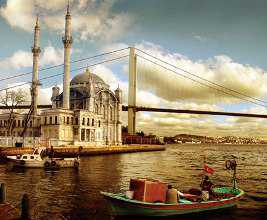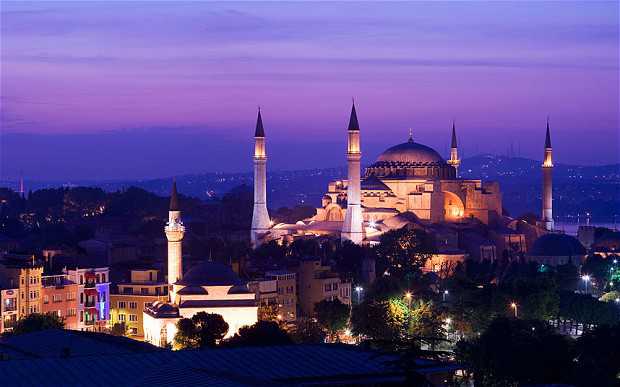
I spent a week in Istanbul. In this week, my shopping mission was accomplished, my childish dream of eating turkey in Turkey was made true, but my plan to discover the city was far away from being even half achieved. I saw a lot, enjoyed a lot, and missed much!
Istanbul is a big city in which every corner, every site has its own long story that is linked to the country’s history. It’s Turkey’s cultural, historical, and economic heart.
Istanbul is the largest and most populous city in Turkey. It’s the second-largest international gateway, after Antalya, receiving about quarter of the country’s foreign tourists.
When it was named a “European Capital of Culture” in 2010, Istanbul welcomed seven million tourists; making the city the world’s tenth most popular tourist destination.The city’s biggest draw is its historic center “Istanbul Old City”; partially listed as a UNESCO World Heritage Site.
Istanbul is also the city of cultural hodgepodge. If you’re European, Asian, Middle Eastern, Arab or Muslim, you’ll definitely find more than one reason to relate to it.
The Turkish language is immensely affected by the Arabic language. Mosques are everywhere and Adhan is easily heard in many places. The food that tourists eat in Turkey like Shawerma (originally Levantine not Turkish), Kofte (Middle Eastern not Turkish), Simit, and Baklava, and drinking Turkish coffee, are all famous and available in the Arab countries. But all these “Arabic” manifestations had a European flavor, which made every previously mentioned item feel new to me!
| My first impression about Istanbul? It’s ancient, beautiful, and vibrant.
It’s very affluent with history, architecture, mosques, and shopping malls. |
Three Empires, Two Continents
Throughout history, this Istanbul was the capital of three empires; Byzantine, Roman, and Ottoman Empires.
It’s also one of very few cities of the whole world that lies in two continents; Asia and Europe.
It straddles the Bosphorus strait, one of the globe’s busiest waterways with many ships, ferries and oil tankers going through it, that separates Asia from Europe and links the Sea of Marmara and the Black Sea.
The tourist industry is intense in the European side of the city; that ninety percent of the city’s hotels are located there.
There are two bridges that link European Istanbul and Asian Istanbul, called the first and the second Bosphorus bridges. These bridges are lightened at night to make them look very beautiful and attractive. And Romantic!
 |
| There are two bridges that link European Istanbul and Asian Istanbul, called the first and the second Bosphorus bridges. |
Bosphorus Strait Cruise
Each and every tourist of Istanbul wants to—and should—take a Bosphorus cruise, trip up the 32 km (20-mile)-long strait.
During this Cruise, one enjoys seeing the architectural and cultural treasures that lie along the shores, the balanced mixture of old and modern (16th century mansions and 20th century suspended bridges) and the Grand Ottoman palaces and historic fortresses. Not to mention the soft breeze and the lungful of unpolluted oxygen one does enjoy.
When I was there I discovered “The Golden Horn”; a small bay which, with Marmara Sea, divides the European side of Istanbul into Old Istanbul and Modern Istanbul.
I found Istanbul to have more and more miles of waterfronts, boats and bridges than I imagined. Very beautiful!
 |
| The street is very addictive, I walked in there almost every day of my trip, utilizing the fact that my hotel is quite close to it. |
Taksim Square
My hotel was in Taksim Square; the heart of modern Istanbul. This square is a major shopping and tourist attraction that is famous for its restaurants, shops and hotels. At the heart of Taqsim is the Monument of the republic.
The Monument of the Republic is an 11 m (36 ft.) high monument that commemorates the founding of the Turkish Republic in 1923. It portrays the founders of the Turkish Republic, depicting Mostafa Kemal Atatürk and his men.
The monument was also erected to challenge the remnants of taboos that had existed from Ottoman era that restricted the depiction of the human form and the compliance with the Sharia of Islam. It’s an important site, where official ceremonies on national holidays are being held.
“Taksim” is an Arabic word which means: division and/or distribution. The history of Taksim square dates back to the Ottoman Empire, when it was the point where the main water lines from the north of Istanbul were collected to be divided and distributed to other parts of the city. The square took its name from the huge stone reservoir which is located in this area.
One of both sides of Istklal Street starts at Taksim square. Istklal is Arabic word which means independence. It is one of the most famous avenues in Istanbul. It’s an elegant three kilometers long busy pedestrian street that is visited by nearly 3 million people in a single day over the course of weekends.
Throughout this street you can find everything; stores of major global brands, branches of McDonald’s, Burger King, Starbucks, Subway, Turkish restaurants and cafés, , historical patisseries, chocolatiers, boutiques, bookstores, art galleries, cinemas, theaters, money exchange, libraries, tattoo salons, music equipment stores and street musicians. The street is surrounded by Ottoman Empire era buildings. It’s the liveliest and the most cosmopolitan place I’ve seen in Istanbul.
The street is very addictive, I walked in there almost every day of my trip, utilizing the fact that my hotel is quite close to it. I preferred walking in it and do more surfing in its shops than sitting and enjoying in any café or even trying its tram. So beware!
My first impression about Istanbul? It’s ancient, beautiful, and vibrant.
It’s very affluent with history, architecture, mosques, and shopping malls.
Actually, it’s affluent with everything. I also found it to be more European than Middle Eastern, and way more secular than Islamic.



Leave a Reply